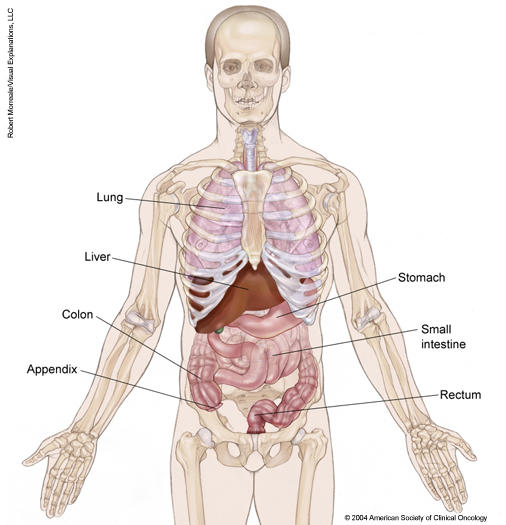ON THIS PAGE: You will find some basic information about this disease and the parts of the body it may affect. This is the first page of Cancer.Net’s Guide to Neuroendocrine Tumors of the Gastrointestinal Tract. Use the menu to see other pages. Think of that menu as a roadmap for this entire guide.
About neuroendocrine tumors
A tumor begins when the DNA of healthy cells is damaged, causing the cells to change and grow out of control, forming a mass. A tumor can be cancerous or benign. A cancerous tumor can grow and spread to other parts of the body if it is not found early and treated. This is sometimes called a malignant tumor.
A neuroendocrine tumor (NET) begins in the specialized cells of the body’s neuroendocrine system. These cells have traits of both hormone-producing endocrine cells and nerve cells. They are found throughout the body’s organs and help control many of the body’s functions. Hormones are chemical substances that are carried through the bloodstream to have a specific effect on how other organs or cells in the body behave. All NETs have the potential to become metastatic. Most NETs take years to develop and grow slowly. However, some NETs can be fast-growing. See the Stages and Grades section to learn more.
NETs can develop in any part of the body. NETs develop most commonly in the gastrointestinal (GI) tract or in the lungs (learn more about NETs of the lung). GI tract NETs and lung NETs used to be called carcinoid tumors. Some NETs start in the pancreas. Rare types of NETs that develop in or on the adrenal glands are called pheochromocytoma or paraganglioma. Learn more about NETs that develop in other parts of the body.
About GI tract NETs
The most common places in the body where NETs form is the GI tract, or digestive system. The body's GI tract starts at the esophagus and ends at the anus. It plays a central role in digesting food and liquid and in processing waste.
In general, many GI tract NETs start in the small intestine or rectum. They can also start in the stomach, appendix, colon, and elsewhere in the GI tract.
Because these tumors develop from neuroendocrine cells, they can make high levels of hormone-like substances called neuropeptides and amines. About 40% of NETs release hormones that lead to symptoms. These tumors are called “functional.” Carcinoid syndrome (see Symptoms and Signs) is a classic type of functional NET and is associated with the release of various substances called hormones. One of these is called serotonin (see Diagnosis), and it can be measured in the urine or blood. In other tumors, the substances may not be released in large enough amounts to cause symptoms, or the substances may be defective and not cause symptoms. These NETs are called “non-functional.”
Looking for More of an Introduction?
If you would like more of an introduction, explore these related items. Please note that these links will take you to other sections on Cancer.Net:
-
Find a Cancer Doctor. Search for a cancer specialist in your local area using this free database of doctors from the American Society of Clinical Oncology (ASCO).
-
Cancer Terms. Learn what medical phrases and terms used in cancer care and treatment mean.
The next section in this guide is Statistics. It helps explain the number of people who are diagnosed with a GI tract NET and general survival rates. Use the menu to choose a different section to read in this guide.

